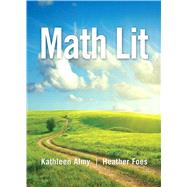
Note: Supplemental materials are not guaranteed with Rental or Used book purchases.
Purchase Benefits
What is included with this book?
Kathleen Almy has been a professor of mathematics at Rock Valley College for over 10 years and has taught high school and college level math for 15 years. She has a bachelor's degree in mathematics education from Southern Illinois University and master's degree in pure mathematics from Northern Illinois University. Her passion is improving developmental math for all students including the development of courses and content that is appropriate, relevant, and meaningful. As her department's developmental math coordinator, she organized and led a successful comprehensive redesign of the program over the past 5 years. As a result of giving talks about the redesign, she has been consulting with colleges throughout Illinois and across the country to improve their developmental math programs. Since 2009, she has been a member of AMATYC's Quantway project which is affiliated with the Carnegie Foundation. She was AMATYC’s Developmental Math Committee chair and serves on several state committees on developmental education.
Heather Foes is currently a professor of Mathematics at Rock Valley College in Rockford, Illinois and has also taught at Illinois State University, Northern Illinois University and the University of Illinois. Heather has a bachelor’s degree in chemistry and mathematics and a master’s degree in mathematics from Illinois State University. She has written solution manuals and other supplemental materials over the last ten years, as well as algorithmic questions for test-generator software and conceptual questions for MyStatLab for Pearson.
CYCLE 1
Part 1: Gear Up
1.1 Focus Problem, Step 1: Understand the Problem
1.2 Getting Started: Syllabus
1.3 Getting Started: Skills
1.4 Getting Started: Groups
1.5 A Tale of Two Numbers (FP)
1.6 Part and Whole
1.7 The Elusive A in Math
1.8 Two by Two
1.9 Multiply or Divide? (FP)
Part 1 Recap
Part 2: Shift Gears
1.10 Focus Problem, Step 2: Devise a Plan
1.11 Higher or Lower? (FP)
1.12 The X Factor
1.13 Take Two and Call Me…
1.14 Good Eats (FP)
1.15 General Number
1.16 Up and Down (FP)
1.17 The Social Network
Part 2 Recap
Part 3: Wind Down
1.18 Focus Problem, Step 3: Carry Out the Plan
1.19 Cookie Monster
1.20 Picture This
1.21 Infinity and Beyond
1.22 Error and Estimation: Liquid Medicine
1.23 Focus Problem, Step 4: Look Back
Cycle Wrap-up
CYCLE 2
Part 1: Gear Up
2.1 Focus Problem, Step 1: Understand the Problem
2.2 It’s All Relative (FP)
2.3 Sign and Size, Part 1 (FP)
2.4 Sign and Size, Part 2
2.5 An Ounce of Prevention
2.6 Measure Up
2.7 Count Up (FP)
Part 1 Recap
Part 2: Shift Gears
2.8 Focus Problem, Step 2: Devise a Plan
2.9 Order Up
2.10 Does Order Matter?
2.11 Fair Share
2.12 Seat Yourself (FP)
2.13 Punt, Pass, Kick
2.14 Ramp Up
2.15 Shortest Distance (Optional)
Part 2 Recap
Part 3: Wind Down
2.16 Focus Problem, Step 3: Carry Out the Plan
2.17 Parts of Speech
2.18 In the Swing of Things (Optional)
2.19 Error and Estimation: Rounding (Optional)
2.20 Focus Problem, Step 4: Look Back
Cycle Wrap-up
CYCLE 3
Part 1: Gear Up
3.1 Focus Problem, Step 1: Understand the Problem
3.2 Rule of Thumb
3.3 Working Hard for the Money (FP)
3.4 A Fine Balance (Optional)
3.5 Just a Pinch
3.6 Separate but Equal (FP)
3.7 On the Rise
Part 1 Recap
Part 2: Shift Gears
3.8 Focus Problem, Step 2: Devise a Plan
3.9 Game On (FP)
3.10 Quarter Wing Night (FP)
3.11 Eastbound and Down (FP)
3.12 Get in Line (FP)
3.13 Gas Up and Go (Optional)
Part 2 Recap
Part 3: Wind Down
3.14 Focus Problem, Step 3: Carry Out the Plan
3.15 Value of a Dollar (Optional)
3.16 When is the Algebra Worth It? (Optional)
3.17 Error and Estimation: Volume
3.18 Focus Problem, Step 4: Look Back
Cycle Wrap-up
CYCLE 4
Part 1: Gear Up
4.1 Focus Problem, Step 1: Understand the Problem
4.2 A Matter of Change (FP)
4.3 Little Giants (FP)
4.4 Outwit and Outlast (FP)
4.5 Chances Are (Optional)
4.6 A Model Approach (FP)
Part 1 Recap
Part 2: Shift Gears
4.7 Focus Problem, Step 2: Devise a Plan
4.8 Chain, Chain, Chain
4.9 Hot and Cold
4.10 Going Viral
4.11 The Cost of College (Optional)
4.12 Tuition Increases (Optional)
Part 2 Recap
Part 3: Wind Down
4.13 Focus Problem, Step 3: Carry Out the Plan
4.14 Outliers (Optional)
4.15 A Little Less (FP)
4.16 Error and Estimation: Order of Magnitude Optional
4.17 Focus Problem, Step 4: Look Back
Cycle Wrap-up
*(FP): Indicates a lesson essential to solving the focus problem
The New copy of this book will include any supplemental materials advertised. Please check the title of the book to determine if it should include any access cards, study guides, lab manuals, CDs, etc.
The Used, Rental and eBook copies of this book are not guaranteed to include any supplemental materials. Typically, only the book itself is included. This is true even if the title states it includes any access cards, study guides, lab manuals, CDs, etc.